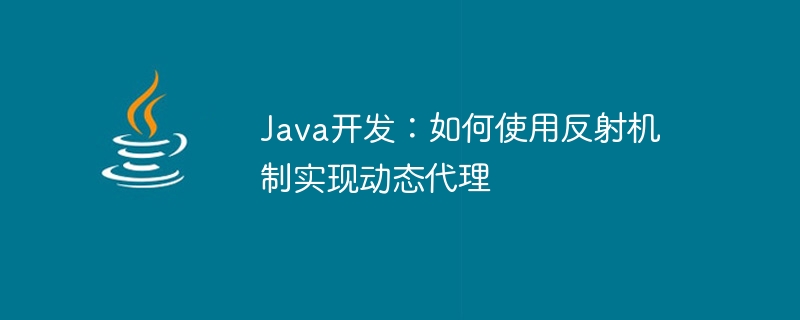

Java development: How to use reflection mechanism to implement dynamic proxy
In Java development, reflection is a powerful and flexible feature that can dynamically load classes at runtime , create objects, call methods, etc. Using the reflection mechanism, we can implement dynamic proxy, that is, create a proxy class object that implements a certain interface when the program is running, and dynamically handle the method calls of the proxy object.
In order to better understand how to use the reflection mechanism to implement dynamic proxy, let's first understand the proxy mode. Proxy pattern is a common design pattern that allows controlling access to a real object through a proxy object and performing some additional operations before or after accessing the object. In dynamic proxying, the proxy object is generated at runtime and dynamically implements the interface of the proxied object.
First, we need to define a proxy interface, for example:
public interface UserService {
void saveUser(User user);
User getUserById(int userId);
}Then, we create a real business class that implements the interface, for example:
public class UserServiceImpl implements UserService {
@Override
public void saveUser(User user) {
System.out.println("Saving user: " + user.getName());
}
@Override
public User getUserById(int userId) {
User user = new User(userId, "John Doe");
System.out.println("Getting user: " + user.getName());
return user;
}
}Connect Next, we create a dynamic proxy class, which must implement the InvocationHandler interface, for example:
import java.lang.reflect.InvocationHandler;
import java.lang.reflect.Method;
public class UserServiceProxy implements InvocationHandler {
private Object target;
public UserServiceProxy(Object target) {
this.target = target;
}
@Override
public Object invoke(Object proxy, Method method, Object[] args) throws Throwable {
System.out.println("Before calling method: " + method.getName());
Object result = method.invoke(target, args);
System.out.println("After calling method: " + method.getName());
return result;
}
} In the dynamic proxy class, we use the InvocationHandler interface #invoke method to handle method calls on the proxy object. Before calling the method of the proxy object, we can output some information to the console; after the call, we can also perform some additional operations.
import java.lang.reflect.Proxy;
public class Main {
public static void main(String[] args) {
UserService userService = new UserServiceImpl();
UserServiceProxy proxy = new UserServiceProxy(userService);
UserService userServiceProxy = (UserService) Proxy.newProxyInstance(
userService.getClass().getClassLoader(),
userService.getClass().getInterfaces(),
proxy
);
User user = new User(1, "Alice");
userServiceProxy.saveUser(user);
userServiceProxy.getUserById(1);
}
}UserServiceObject and its corresponding proxy objectUserServiceProxy. Then, we use the newProxyInstance method of the Proxy class to create a dynamic proxy object, passing in the UserService object’s class loader, interface list and proxy objectUserServiceProxy. Finally, we can implement dynamic proxy by calling the method of the proxy object through the proxy object.
Before calling method: saveUser Saving user: Alice After calling method: saveUser Before calling method: getUserById Getting user: John Doe After calling method: getUserById
The above is the detailed content of Java development: How to use reflection mechanism to implement dynamic proxy. For more information, please follow other related articles on the PHP Chinese website!
 What are the calling methods of java reflection
What are the calling methods of java reflection
 How to clean the C drive when it turns red
How to clean the C drive when it turns red
 Usage of SetTimer function
Usage of SetTimer function
 How to import easygui in vscode
How to import easygui in vscode
 How to use imfinfo function
How to use imfinfo function
 Tutorial on merging multiple words into one word
Tutorial on merging multiple words into one word
 Google earth cannot connect to the server solution
Google earth cannot connect to the server solution
 plugin.exe application error
plugin.exe application error




